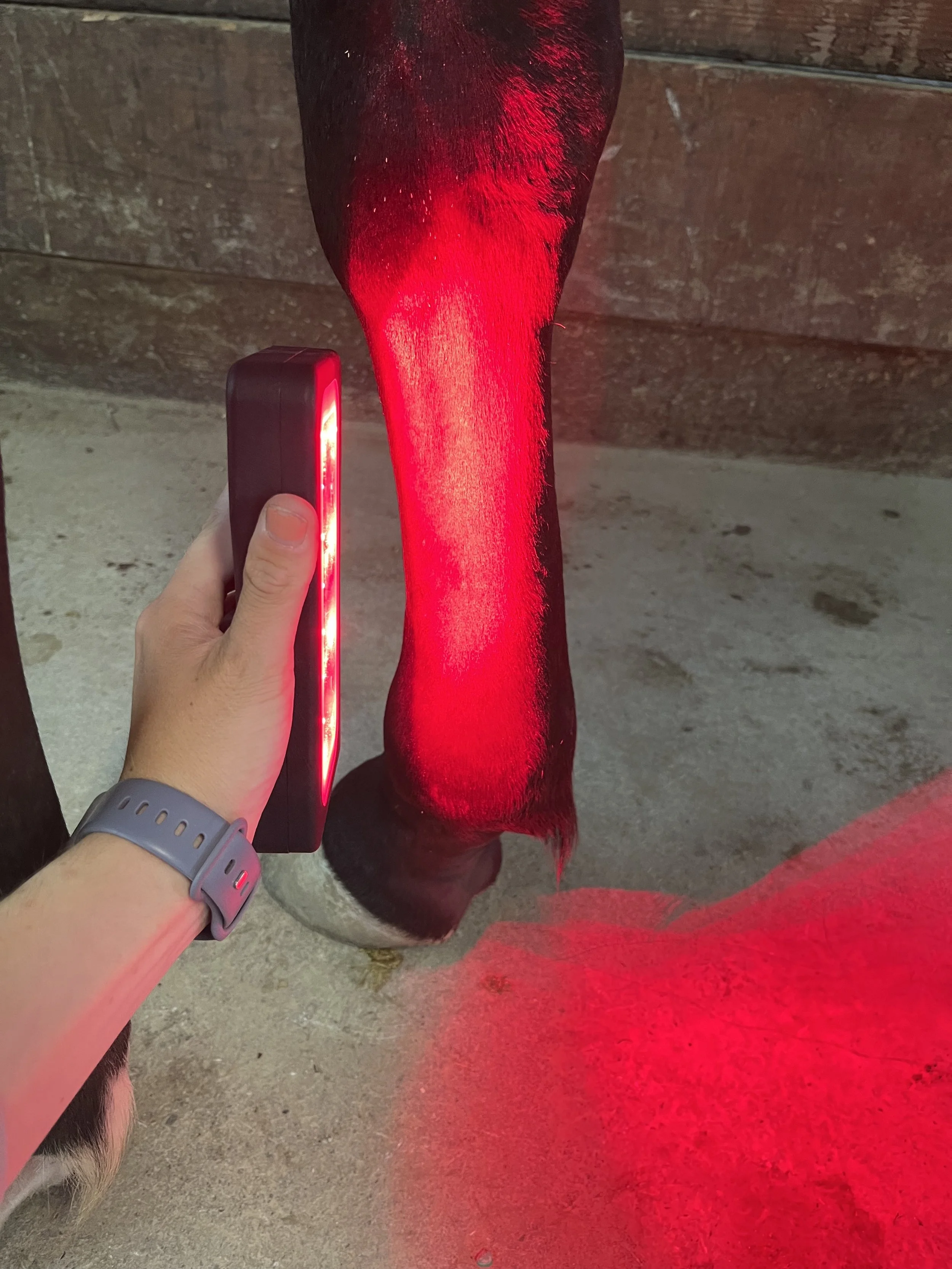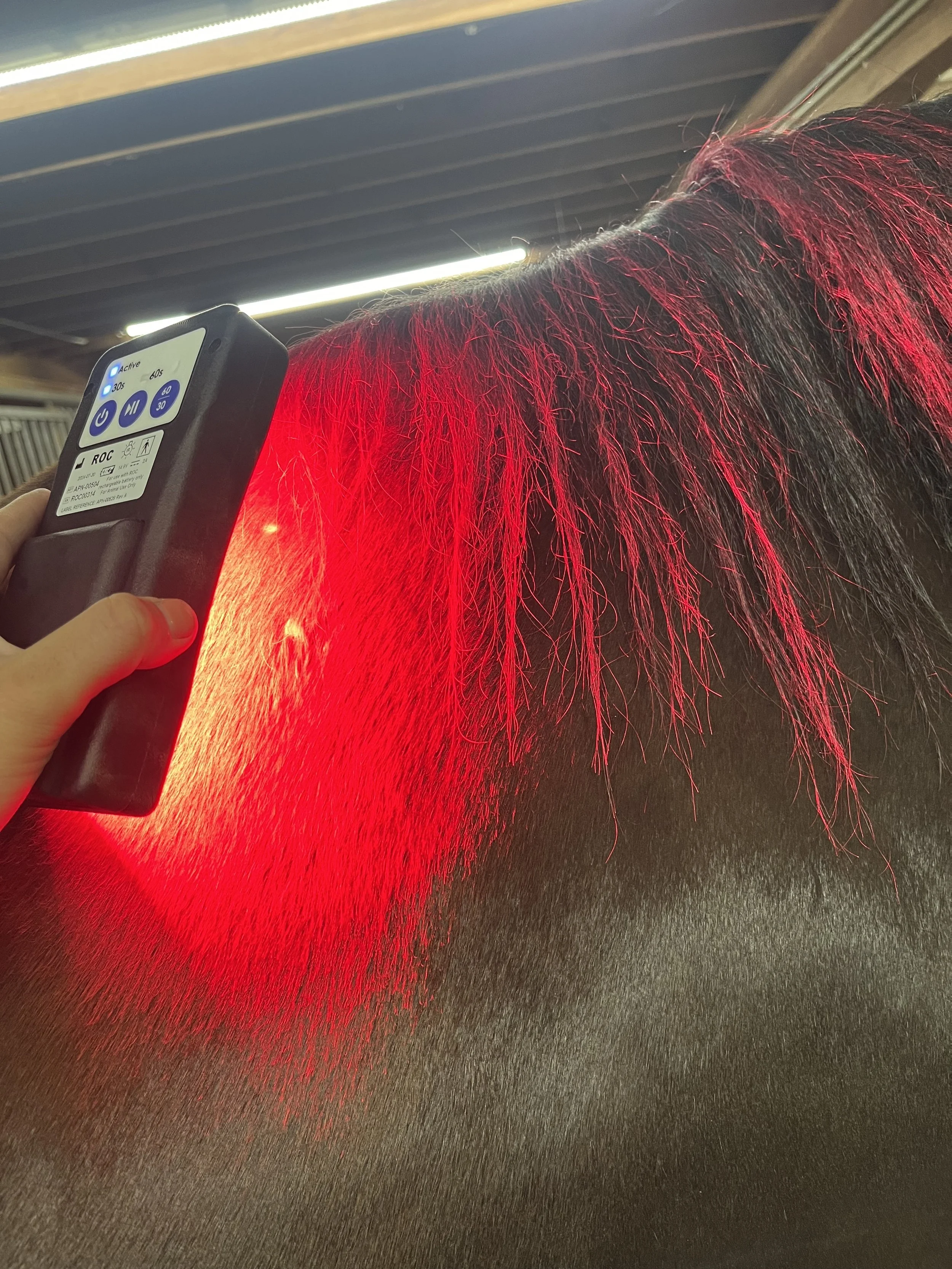What is Regeneration, Oxygenation, Circulation Red Light?
Red Light (ROC) therapy is a non-invasive and painless way to treat a variety of equine and animal conditions by stimulating cellular repair and improving circulation. ROC is a therapeutic approach that utilizes specific wavelengths of light to target and benefit various health conditions. In this technique, particular rays of light are harnessed and directed onto specific areas of the body for therapeutic purposes. The energy provided by red light therapy serves as a catalyst for a series of positive changes within the body. It enhances blood supply to the treated area and accelerates cellular metabolism. As a result, the cells receive more oxygen and nutrients, aiding in the removal of cellular waste and supporting tissue healing.
Choosing Red Light Therapy
-
Description text goes hereArthritis, tendonitis, and muscle strains are common conditions that can cause pain and inflammation in horses. These conditions can be caused by a variety of factors, including overuse, injury, or age-related wear and tear. As a result, they can negatively impact a horse’s performance, comfort, and overall well-being.
Red light therapy for horses can be a highly effective treatment option for these conditions. By using red or near-infrared light to penetrate deep into the tissues, red light therapy can help increase blood flow, reduce inflammation, and promote the natural healing processes of the body.
Inflammation is the body’s natural response to injury or infection, but it can also cause pain and discomfort. Red light therapy has been shown to help reduce inflammation by increasing circulation and promoting the release of anti-inflammatory cytokines. This can help reduce pain and swelling in the affected area, allowing the horse to move more comfortably.
In addition to reducing inflammation, red light therapy can also help stimulate the production of collagen, which is essential for healthy joint function. Collagen is a protein that helps provide cushioning and support for the joints, and it is often depleted in horses with arthritis or other joint-related conditions. By promoting the production of collagen, red light therapy can help improve joint function and reduce pain in horses with these conditions.
-
Injuries and wounds are an unfortunate reality for horses, particularly those that are involved in athletic activities such as racing or jumping. While rest and proper care are essential for the healing process, red light therapy can also be a beneficial tool to help speed up recovery time and get your horse back to their normal routine more quickly.
Red light therapy works by stimulating cellular repair and regeneration, which can help to improve the healing process for injuries and wounds. When red or near-infrared light penetrates the skin, it interacts with the cells in the body, stimulating the production of ATP (adenosine triphosphate). ATP is the primary source of energy for cellular function and repair, so by increasing ATP production, red light therapy can help speed up the healing process.
In addition to increasing ATP production, red light therapy can also help to improve circulation. Improved circulation can help to deliver oxygen and nutrients to the site of the injury or wound, which can further promote healing. Increased circulation can also help to remove waste products from the site, such as lactic acid, which can cause discomfort and pain.
The combination of increased cellular repair and improved circulation can have a significant impact on the healing process for injuries and wounds. In many cases, horses that receive red light therapy may be able to return to their normal routine more quickly than those that do not.
It is important to note that the effectiveness of red light therapy for injuries and wounds will depend on the severity and nature of the injury or wound. In some cases, more extensive treatment may be required. However, for many horses, red light therapy can be a valuable tool to help speed up the healing process and get them back to their best.
-
Anxiety and stress are common issues that horses can experience, particularly when they are in new environments or undergoing changes in their routine. These issues can lead to negative behavioral changes and may even have an impact on a horse’s overall health and well-being. However, red light therapy can be an effective tool for helping to reduce anxiety and promote relaxation in horses.
Red light therapy has been shown to have a calming effect on the body, which can help to reduce anxiety and stress in horses. The therapy works by stimulating the production of serotonin, a neurotransmitter that is associated with feelings of well-being and happiness. Serotonin is also involved in regulating mood, sleep, and appetite, so by promoting the production of this neurotransmitter, red light therapy can help to promote relaxation and calmness in horses.
In addition to promoting the production of serotonin, red light therapy can also help to reduce the levels of cortisol in the body. Cortisol is a stress hormone that is produced in response to stress or anxiety, and high levels of cortisol can lead to negative health effects, including weight gain and weakened immune function. Red light therapy has been shown to help reduce the levels of cortisol in the body, which can help to alleviate stress and anxiety in horses.
Red light therapy can be a valuable tool for helping horses to manage stress and anxiety, particularly in new or unfamiliar environments. By promoting relaxation and calmness, red light therapy can help horses to feel more comfortable and at ease, which can have a positive impact on their behavior and overall well-being.
If you have a horse that is prone to stress or anxiety, consider incorporating red light therapy into their care regimen
-
Performance horses, especially; endurance horses, have to bear a lot of strain on their back during high jumps and walking on uneven rocky trails. Slight tendon tears or micro-muscle injuries can cause chronic musculoskeletal pain if not recovered timely. Most of these injuries remain unnoticed and hard to diagnose. Suppose your horse shows reduced performance, behavioral changes and discomfort to grooming and compression on the back. In that case, your horse may be suffering from back pain.
A study published in the Journal of Equine Veterinary Science proved the effectiveness of red light therapy against back pain. Sixty-one quarter horses were treated, and light treatment proved beneficial against back pain and trunk stiffness. The study also concluded that chiropractic treatment proves more effective when complemented with light therapy.
-
Open wounds in horses require proper rest and meticulous care to avoid complications. Veterinary attention is, of course, essential in addressing the initial injury and assessing its severity. Complementary therapies can, however, play a significant role in expediting the healing process and preventing infection.
Red light therapy has emerged as a remarkable complementary therapy for wound healing in horses. It complements veterinary care by stimulating the natural healing processes of the body. Here are a couple of notable examples that underscore the efficacy of red light therapy in wound healing:
Real-life Success Story:
To the right, a horse that suffered a deep laceration to its leg, a situation that can be particularly challenging to manage. In this case, the horse received daily red light therapy sessions, along with some sessions of Pulsed Electromagnetic Field (PEMF) therapy, all under the guidance and approval of a veterinarian for complementary care. The results were impressive, demonstrating the positive impact of red light therapy on wound healing.
Scientific Validation:
In a compelling research study conducted in 2012, eight horses were subjected to identical incisions on the metacarpal region of their legs. An experimental group was treated using red light therapy, while the control group received standard care. After eighty days, histopathological examination of the wounded area delivered unequivocal evidence of red light therapy's effectiveness. Horses treated with red light therapy exhibited complete healing, underscoring its potential to significantly expedite the wound recovery process.
In summary, red light therapy, with its ability to penetrate deeply into tissues and stimulate cellular regeneration, proves to be a valuable asset in the equine world. By enhancing the natural healing mechanisms of the body, it not only aids in wound recovery but also contributes to overall equine well-being, offering a ray of hope for horses facing the challenge of open wounds.
-
Red light therapy is particularly effective in cases of tissue injuries, such as strains, sprains, or wounds. The deep tissue penetration and cellular-level healing provided by red light therapy make it an excellent choice for these situations.
Red light therapy also stimulates the formation of new capillaries, which can expedite the healing of injuries and damaged tissues. Workout and strenuous activities leave the horse with muscles, tendons, and associated connective tissue micro-injuries. This can also be the simple sore muscle after exercise. The light therapy can reduce the delayed onset muscle soreness (DOMS) and prepare the horses tissues for the next workout.
Tendons, ligaments and other soft tissue injuries are a bit tricky to provide relief. And most of the time, when they remain undiagnosed for some time, the condition aggravates.
-
Red light therapy encourages the production of collagen, a crucial protein for tissue regeneration and skin health. Red light therapy also helps in the healing process by increasing the amount of collagen protein. Collagen makes one-third of the total proteins in the body and plays a pivotal role in healing injuries. By increasing the amount of collagen, red light keeps the skin elasticity and joints healthy.
-
By increasing serotonin production, red light therapy helps reduce inflammation, which is often a key contributor to various health issues.
-
The therapy promotes increased blood flow, ensuring that more nutrients and oxygen reach the tissues, thus facilitating the healing process.
-
When you need to expedite the healing process, such as when preparing for a competition or recovering from an injury, red light therapy's ability to stimulate cellular regeneration is a key advantage.
In summary, red light therapy operates at the cellular level, where it enhances vital physiological processes. This natural and non-invasive approach to healing has been embraced for its ability to stimulate the body's innate mechanisms for repair and regeneration, making it a valuable tool in equine care and other forms of therapy.
-
The health and appearance of a horse’s coat is an important indicator of their overall well-being. A shiny, healthy coat not only looks beautiful, but it also reflects good health and proper nutrition. While proper grooming and a balanced diet are key factors in maintaining a horse’s coat, red light therapy can also play an important role in improving the condition of their coat.
Red light therapy stimulates the body’s natural healing processes, increasing blood flow and oxygenation to the skin. This increased circulation helps to nourish the hair follicles, promoting healthy hair growth and improving the overall condition of the coat. In addition, red light therapy can help to stimulate the production of collagen and elastin, which are essential proteins for healthy skin and hair.
One of the key benefits of red light therapy for a horse’s coat is that it can help to improve the coat’s shine and vibrancy. By stimulating blood flow and cellular repair, red light therapy helps to create a healthy glow and luster to the coat. This is particularly important for horses in competition, as a shiny, healthy coat can make a big difference in their overall appearance.
Moreover, a healthy coat can also help to boost a horse’s self-confidence and well-being. When a horse looks and feels their best, they are more likely to perform at their peak, both in the ring and in their daily activities. This can translate to a happier, healthier horse overall.


